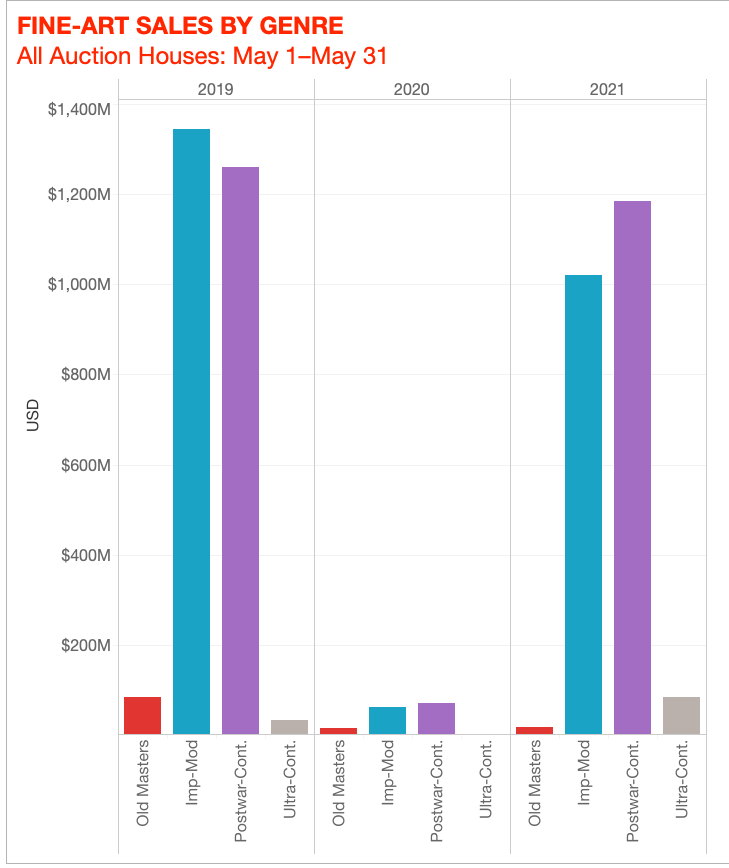Artnet News Pro
Which Segment of the Art Market Grew the Most in Last Month’s Mega-Sales? We Crunched the Numbers
We read the tea leaves in data from the Artnet Price Database to give you a sense of what's in store.

We read the tea leaves in data from the Artnet Price Database to give you a sense of what's in store.

by
Julia Halperin

By now, you’ve likely heard that the marquee spring art evening sales held in Hong Kong and New York last month fared almost as well as their pre-lockdown equivalents, signaling a robust comeback for the art market. But top-line totals only tell us so much. Which segments of the market are the most robust coming out of 2020?
A look at the figures shows that while Impressionist and Modern and Postwar and contemporary art continue to deliver the biggest prices at auction, the fastest-growing segment of the market is for the young guns.
Sales of ultra-contemporary art (which we define as work made by artists born in 1975 or later) ascended around 142 percent from 2019 to 2021, from $35.7 million to $86.7 million last month.
What does this tell us about the current and future state of the market? Read on for answers.

© Artnet Analytics 2021.
The Impressionist and Modern and Postwar and contemporary categories. (We define these by artist’s birthdates: Imp-Mod covers artists born from 1821 through 1910, and P.W.C. covers artists born from 1911 through 1974.) That makes sense, considering that last month saw the return of the marquee spring New York evening auctions, led by Picasso’s $103 million portrait of Marie-Thérèse and a couple major Basquiats. A whopping total of $1 billion worth of Imp-Mod art and $1.2 billion worth of P.W.C. art sold at auction worldwide last month.
Last month’s Imp-Mod sales were down about 25 percent, or $318 million, compared to the same month in 2019. Postwar and contemporary sales were down less: a slim six percent, or $76 million.
Last month also saw P.W.C. take the crown from Imp-Mod as the most lucrative genre, a reversal from the equivalent 2019 sales. The category—which includes work by artists including big-sellers Basquiat, Andy Warhol, and Gerhard Richter—outsold Imp-Mod by $158 million.
It’s not me who’s obsessed, it’s the broader collecting public! The ultra-contemporary segment was the only slice of the market to grow substantially between May 2019 to May 2021.
In fact, the total generated by sales of ultra-contemporary art at auction last month was up a whopping 142 percent over May 2019. (That year, the segment generated $35.7 million; this year, $86.7 million. Like I said, not my obsession!)
Sure, some of it can be attributed to greater supply. It’s certainly much harder to find a fresh-to-market Monet than, say, a fresh-to-market Matthew Wong or Harold Ancart, since most of their works are hitting the block for the first time.
But consider that the number of ultra-contemporary lots offered last month is up only around 50 percent from May 2019, while total sales in the category are up over 140 percent in the same period. That suggests that collectors’ desire to spend big on these works is fueling the growth more than anything else.
Just as Postwar and contemporary has taken the mantle from Imp-Mod as the juiciest slice of the auction market, it may be only a matter of time before ultra-contemporary takes the lead. Tastes evolve and collectors increasingly want to be seen as engaged with the art of their time.
Prices in the sector are already going up quickly. In May 2019, only seven ultra-contemporary works sold in the $1 million-to-$10 million range. Last month, that figure almost tripled, to 19. That said, there’s a long way to go before this upstart segment starts pulling in over $1 billion during marquee evening sales.